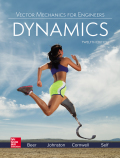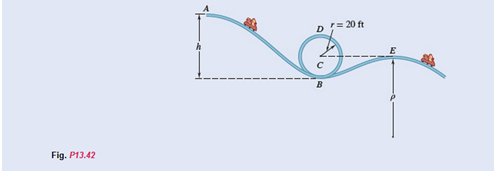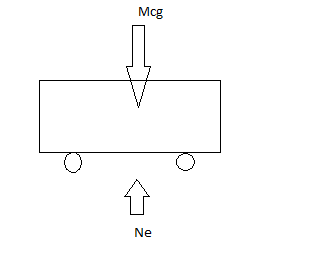
Concept explainers
A roller coaster starts from rest at A, rolls down the track to B, describes a circular loop of 40-ft diameter, and moves up and down past point E. Knowing that

(a)
Estimate the force exerted by the seat on the rider by using given information.
Answer to Problem 13.42P
The value of force at point B is NB=1120Ib and at point D is ND=160Ib.
Explanation of Solution
Given information:
Diameter=40ft
Height=60ft
The force exerted by the seat on the rider at point B and D.
Consider the free body diagram we get,
Mass of the rider is
Acceleration due to gravity is
Resultant acceleration acting on the rider at the point B is
Normal force exerted on the rider by the seat at the point B is
Resolve the forces acting on the rider by Newton’s second law.
Apply the principle of work and energy to the roller coaster at point A and point B.
Acceleration acting on the rider at the point B
Work done by the rider in reaching position B from position A is
The rider is at rest at position A is,
Then the kinetic energy of the rider at point B is,
Then the work done by the rider in reaching position B from position A,
Substitute above values we get,
Resultant acceleration acting on the rider at point B travelling in a circular track with radius of the curvature is r.
Substituting required values in the above equation we get,
Substitute
Now we get,
Forces acting on the riders by Newton’s second law
Apply the principle of work and energy to roller coaster at point A and point D. To determine the resultant acceleration acting on the rider at the point B is,
Work done by the rider in reaching position D from position A is
The rider is at rest at position A is,
Kinetic energy of the rider at point D is,
Work done by the rider in reaching position D from position A is
Substituting required values in equation 4 we get,
Express the resultant acceleration acting on the rider at point D travelling in a circular track with radius of curvature r.
Substitute h and r values we get,
Substitute required values we get,
Then,
(b)
The minimum value of radius of curvature by using given information.
Answer to Problem 13.42P
The value of radius of curvature at point E is=80ft determined below.
Explanation of Solution

Resolve the forces acting on the rider by Newton’s second law.
Roller coaster not to leave the tract at point E we get,
Apply the principle of work and energy to roller coaster at point A and point E.
Find the resultant acceleration acting on the coaster at the point E is,
The rider is at rest at position A.
Kinetic energy of the coaster at point E is,
Equating these two we get,
Substitute required values in above equation we get,
Resultant acceleration acting on the coaster at point E travelling in a circular track with radius of curvature is
Substitute above values we get,
Want to see more full solutions like this?
Chapter 13 Solutions
Vector Mechanics For Engineers
- A garden hose attached with a nozzle is used to fill a 20-gal bucket. The inner diameter of the hose is 1 in and it reduces to 0.53 in at the nozzle exit. The average velocity in the hose is 8 ft/s and the density of water is 62.4 lbm/ft3. NOTE: This is a multi-part question. Once an answer is submitted, you will be unable to return to this part. Determine the volume and mass flow rates of water through the hose. The volume flow rate of water through the hose is ft3/s. The mass flow rate of water through the hose is lbm/s. The change in time? What is the exit velocity?arrow_forwardA 23-ft3 rigid tank initially contains saturated refrigerant-134a vapor at 160 psia. As a result of heat transfer from the refrigerant, the pressure drops to 50 psia. NOTE: This is a multi-part question. Once an answer is submitted, you will be unable to return to this part. Determine the final temperature. Use data from refrigerant tables. The final temperature is ºF.arrow_forwardA 23-ft3 rigid tank initially contains saturated refrigerant-134a vapor at 160 psia. As a result of heat transfer from the refrigerant, the pressure drops to 50 psia. NOTE: This is a multi-part question. Once an answer is submitted, you will be unable to return to this part. Determine the heat transfer. The heat transfer is Btu.arrow_forward
- The shaft shown in the figure below is subjected to axial loads as illustrated. The diameters of segments AB, BC, and CD are 20mm, 25mm, and 15mm, respectively. If the modulus of elasticity of the material is 610 MPa. Determine the change of A to D lengtharrow_forwardDetermine the final pressure and temperature. The final pressure is kPa. The final temperature is ºC.arrow_forwardAir enters the 1-m2 inlet of an aircraft engine at 100 kPa and 20°C with a velocity of 184 m/s. Determine the volume flow rate, in m3/s, at the engine’s inlet and the mass flow rate, in kg/s, at the engine’s exit. The gas constant of air is R = 0.287 kPa·m3/kg·K. The volume flow rate at the engine’s inlet m3/s. The mass flow rate at the engine’s exit is kg/s.arrow_forward
- The ventilating fan of the bathroom of a building has a volume flow rate of 33 L/s and runs continuously. If the density of air inside is 1.20 kg/m3, determine the mass of air vented out in one day. The mass of air is kg.arrow_forwardA steady-flow compressor is used to compress helium from 15 psia and 70°F at the inlet to 200 psia and 600°F at the outlet. The outlet area and velocity are 0.01 ft2 and 100 ft/s, respectively, and the inlet velocity is 53 ft/s. Determine the mass flow rate and the inlet area. The gas constant of helium is R = 2.6809 psia·ft3/lbm·R. The mass flow rate is lbm/s. The inlet area is ft2.arrow_forward1. The maximum and minimum stresses as well as the shear stress seen subjected the piece in plane A-A. Assume it is a cylinder with a diameter of 12.7mm 2. Draw the Mohr circle for the stress state using software. 3. Selection of the material for the prosthesis, which must be analyzed from the point of safety and cost view.arrow_forward
 Elements Of ElectromagneticsMechanical EngineeringISBN:9780190698614Author:Sadiku, Matthew N. O.Publisher:Oxford University Press
Elements Of ElectromagneticsMechanical EngineeringISBN:9780190698614Author:Sadiku, Matthew N. O.Publisher:Oxford University Press Mechanics of Materials (10th Edition)Mechanical EngineeringISBN:9780134319650Author:Russell C. HibbelerPublisher:PEARSON
Mechanics of Materials (10th Edition)Mechanical EngineeringISBN:9780134319650Author:Russell C. HibbelerPublisher:PEARSON Thermodynamics: An Engineering ApproachMechanical EngineeringISBN:9781259822674Author:Yunus A. Cengel Dr., Michael A. BolesPublisher:McGraw-Hill Education
Thermodynamics: An Engineering ApproachMechanical EngineeringISBN:9781259822674Author:Yunus A. Cengel Dr., Michael A. BolesPublisher:McGraw-Hill Education Control Systems EngineeringMechanical EngineeringISBN:9781118170519Author:Norman S. NisePublisher:WILEY
Control Systems EngineeringMechanical EngineeringISBN:9781118170519Author:Norman S. NisePublisher:WILEY Mechanics of Materials (MindTap Course List)Mechanical EngineeringISBN:9781337093347Author:Barry J. Goodno, James M. GerePublisher:Cengage Learning
Mechanics of Materials (MindTap Course List)Mechanical EngineeringISBN:9781337093347Author:Barry J. Goodno, James M. GerePublisher:Cengage Learning Engineering Mechanics: StaticsMechanical EngineeringISBN:9781118807330Author:James L. Meriam, L. G. Kraige, J. N. BoltonPublisher:WILEY
Engineering Mechanics: StaticsMechanical EngineeringISBN:9781118807330Author:James L. Meriam, L. G. Kraige, J. N. BoltonPublisher:WILEY





